Trackside Details
What makes a good model is attention to detail, and there are a lot of small details around a railway line that can provide a subtle sense of place when included in a model. This page shows some typical images of these.
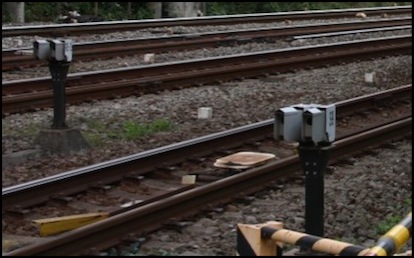
Crossing Sensors (by grade crossing) (2011, Tōkyō)
Railway: Odakyū Odawara Line
Location: near Shinjuku Station
Photographer: afcowie
Note both the sensors on posts, which detect obstructions (like cars or people) on the tracks within the crossing, and the plate between the rails, which is likely part of the control system for detecting a train.

Electrical Duct Crossing Tracks (by grade crossing) (2006, Tōkyō)
Railway: Keisei
Location: Keisei Kanamachi Station
Photographer: LERK

Multiple ducts between tracks in a station (2005)
Railway: JR East Tōhoku or Yamagata Shinkansen Line
Location: uncertain
Photographer: Kouchiumi
Electrical lines for both signals and for power return from the rails (which form the ground half of the circuit for electric trains) are placed in concrete ductwork along and around Japanese railway lines. These often have sectional lids that can be lifted off for maintenance purposes.
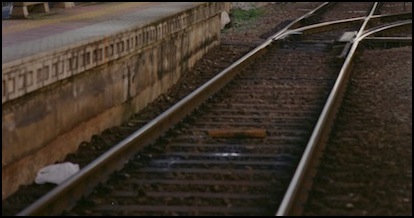
Rusty Track ATC transducer (2009, Tōkyō)
Railway: Toden Arakawa
Location: Minowabashi Station
Photographer: haribote
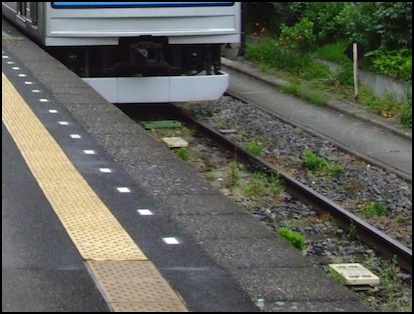
ATC Transducers and Duct (2006, Kawasaki)
Railway: JR East Tsurumi Line
Location: Ōgimachi Station
Photographer: LERK
Train signaling systems include elements placed visibly between the rails to transmit information to the train, and in some cases to capture information from the train. I’m going to call these “ATC Transducers” for lack of a more suitable compact name (not all of them may be technically transducers, some systems use simple electromagnets or permanent magnets). In the second photo, a cable duct with removable lids can be seen on the right. It’s typical to see two closely-spaced ATC transducers like this near the end of a line (which this is) or at other stopping positions. The green lid is probably an access to a wiring junction box, but I can’t be sure.
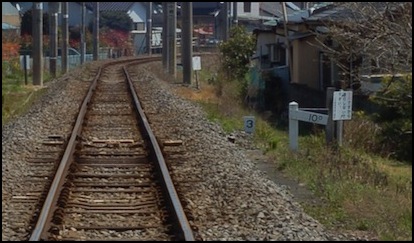
Grade indicatior and other signs (2007, Fujinomiya)
Railway: JR Central
Location: somewhere in Fujinomiya
Photographer: solidaster
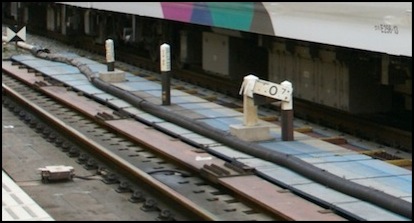
Grade Indicator in station (2008, Tōkyō)
Railway: JR East
Location: Shinjuku Station
Photographer: D A J Fossett (DAJF)
The typical form of a grade-indicator is a vertical white post with a white signboard angled up for ascending grades and down for descending. In Japan, these appears to be marked in units per thousand, with a decimal. In the upper photo of Fujinomiya, the grade indicated (“10.0”) is probably a 1% grade. In some cases, as in the Shinjuku station photo above, one post between two lines indicates both, with the backside painted black to avoid confusion. The marking here (large “0”, small “7”), probably means 0.7 per thousand, or 0.07 percent grade (which is barely a grade and probably noted only so station staff will know an uncoupled train could roll away. The Shinjuku photo also shows how congested with equipment station-area tracks can get, with a variety of ducts, posts. signs and ATC transducers.
The purpose of the other white posts and signs is unclear. In the Fujinomia photo, the sign may be a kilometer or tenth-kilometer marker, or it could be associated with whatever equipment is between the rails (likely an ATC transducer). In the station photo, some may indicate stopping positions for various types or lengths of train to properly align with the platform. The sign with the sideways white triangles is an “end of speed limit”/“end of speed restriction” indicator.
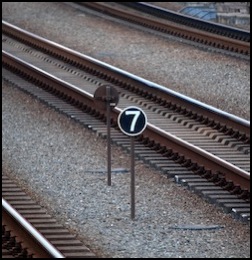
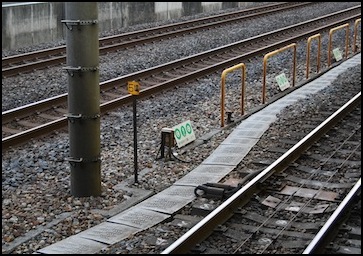
ATC Track Circuit Number signs between stations (2010)
Railway: unknown
Location: Japan
Photographer: toshinori baba (both)
Automatic Train Control (ATC) is the formal name for the type of signaling system used to indicate to a train such details as speed limits or restrictions, or mandatory stopping points. This is related to the track circuits and modern systems utilize transducers located between the rails as described above. But there are also signs to indicate to train crew and maintenance staff which circuit is which. These are numbered away from the station, with circuit 1 being the first (I think the first beyond the station, with anything within station bounds being distinct, but that part is unclear). There are several forms these signs can take.
In the rightmost photo, additional details can be seen, including the electrical conections to the rails for power, ducts and the yellow safety fence between the tracks. The purpose of the wires suspected between the tracks isn’t clear, but these may be part of an ATC system.
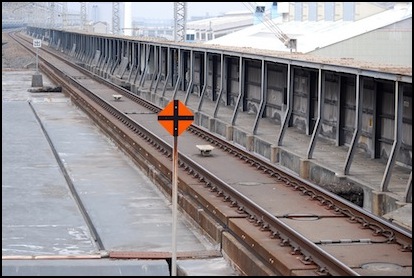
Shinkansen ATC Signs (2010, Ōmiya)
Railway: Tōhoku Shinkansen
Location: Ōmiya Station
Photographer: toshinori baba
The foreground sign indicates an end-of-track-circuit location (or in the case, I think it’s the start-of-track-circuit). You will also see these located a few feet short of end-of-track buffers. The more distance sign with the Kanji symbol for “out” makes the location of the transducer for the “starting signal” for trains departing the station (just visible are the two horizontal bars of the signal transducer between the rails, or possibly that’s a detector). Two other ATC transducers (raised white rectangles) are also visible.
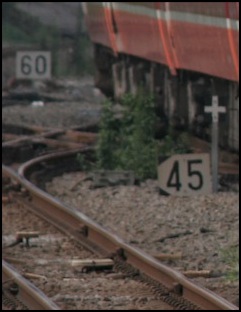
Multiple signs at crossover (2005)
Photographer: unknown (original removed from wikipedia before credit recorded)
The black sign with the white cross is a “Vehicle Stop Sign”, and I suspect it marks the fouling point of the switch, beyond which a train must not pass if the switch is set against it. The two rectanglular signs are speed limits, the first (with the black corners) indicating speed (in kph) through the crossover switches, and the second indicating speed beyond the switches.
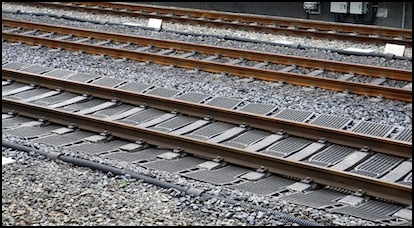
Ballast Mats at Toyohashi Station on the Tōkaidō Shinkansen line (2008)
Photographer: 天然ガス (Tennen-Gas)
Shinkansen lines are often built using concrete slab track. But not always. However because of the high speeds they use, the potential for a ballast stone to be thrown and do some serious damage exists, so in some places they put down mats on the ballas to help keep it in place, as seen in this photo. This appears to be a high-speed line through a station, rather than one of the platform tracks where trains would stop, although I don’t know enough about the station to be sure of that.




